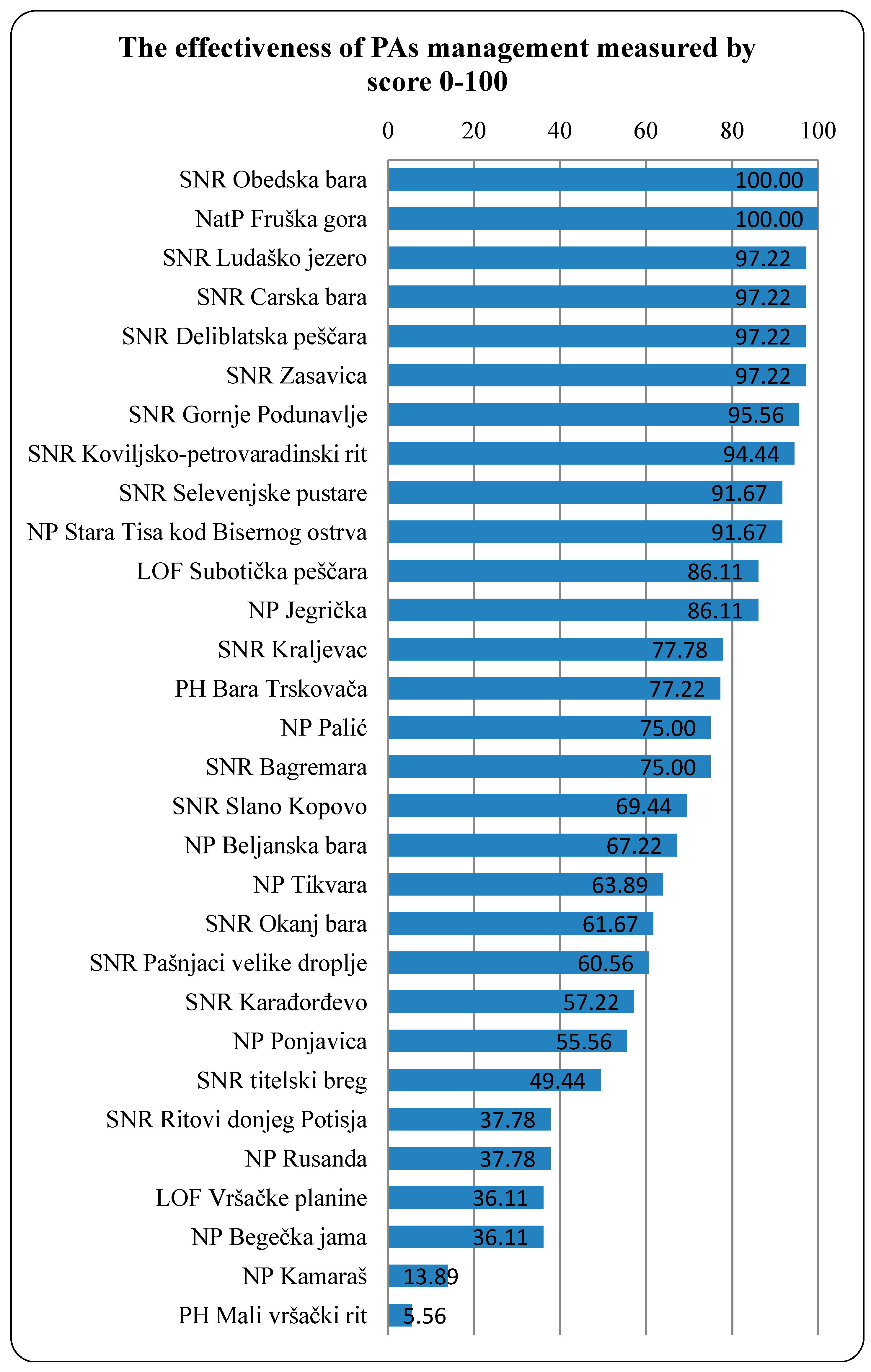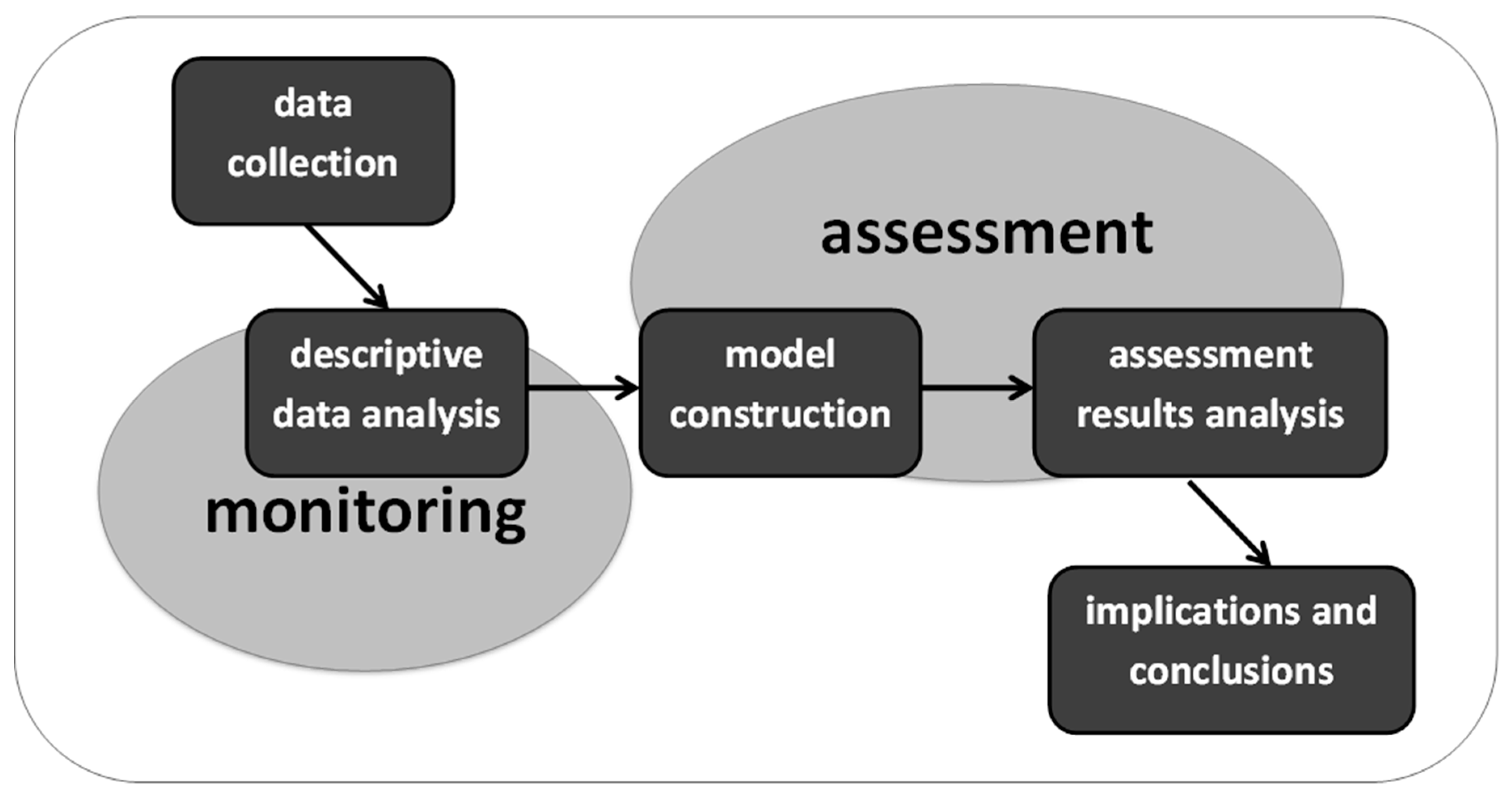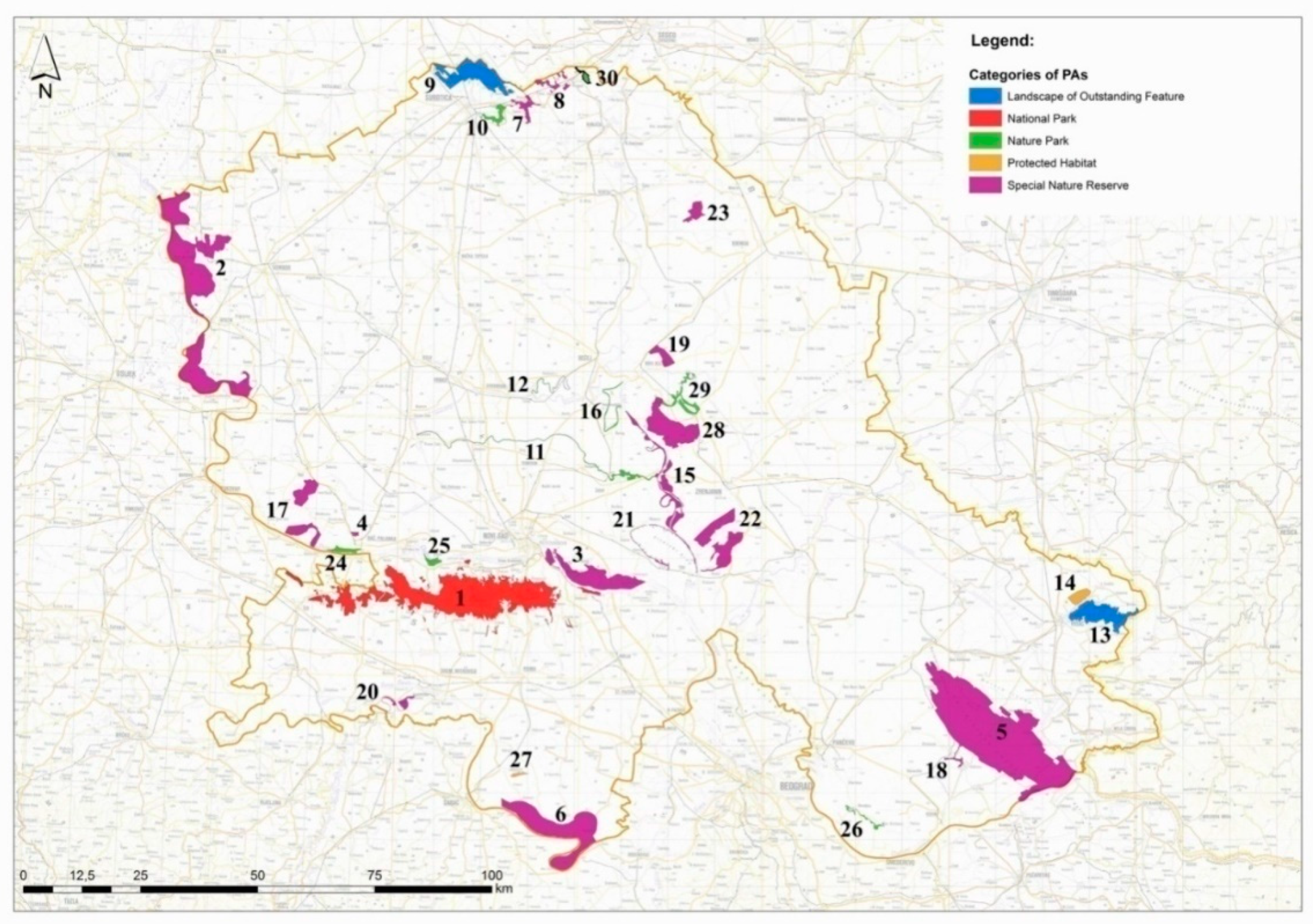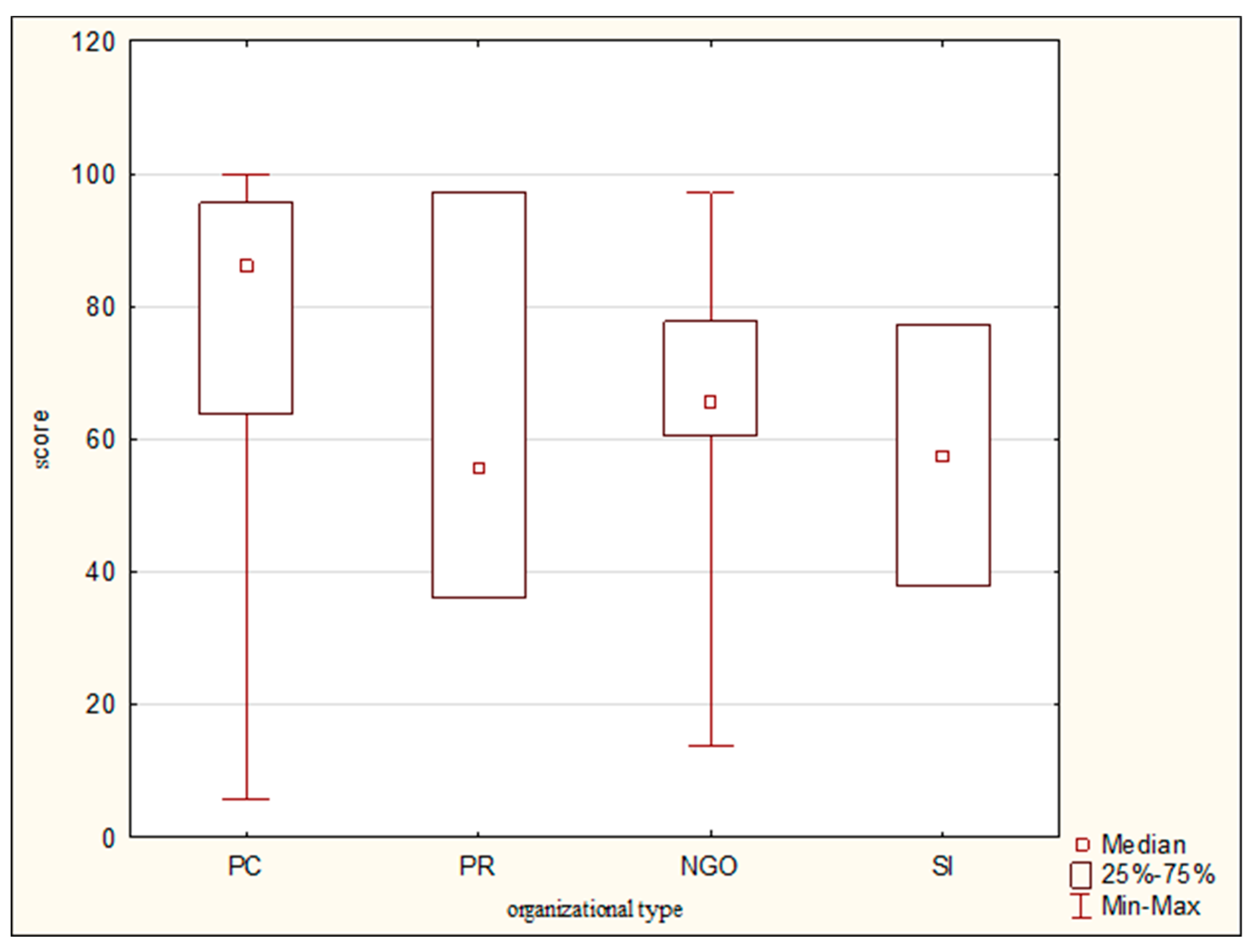Monitoring and Assessment of Protected Areas’ Management Capacities in the Republic of Serbia
Abstract
1. Introduction
2. Situation in the Republic of Serbia
- (1)
- Monitoring—to analyze if and to what extent legal entities meet the criteria for performing tasks of protected area management for the period 2010–2014;
- (2)
- Assessment—to assess the management effectiveness based on the existing parameters, as well as to explore the correlation between the management effectiveness on one side, and the external properties of the protected areas on the other side.
3. Methods and Data Analysis
3.1. Study Site Selection
3.2. Variable Selection
3.3. Empirical Analysis
- A1: 1—if the Protected area management plan existed; 0—otherwise;
- A2: 1—if Professional staff consisted of at least three employees; 0—otherwise;
- A3: 1—if the Ranger service consisted of at least three employees; 0—otherwise;
- B1: number of Annual management plans in 2010–2014 period, divided by five;
- B2: 1—if the Rulebook of charges existed; 0—otherwise;
- B3: 1—if the Rulebook on protected area’s interior order and guarding existed; 0—otherwise
- C1: number of projects classified into five categories (values 0–4). Value 0 corresponds to 0 started or completed projects in 2010–2014 period, whereas values 1 to 4 correspond to quartile distribution of numbers of started or completed projects;
- C2: 1—if Monitoring of species was performed; 0—otherwise;
- C3: 1—if Participation in the education of EU integration in the field of nature conservation was performed; 0—otherwise;
- C4: 1—if Educational and promotional programs were performed; 0—otherwise;
- C5: 1—if Administrative e-database existed; 0—otherwise;
- C6: 1—if Biodiversity e-database existed; 0—otherwise;
- C7: 1—if Tourist paths existed; 0—otherwise;
- C8: 1—if Visitors’ center existed; 0—otherwise;
- C9: 1—if organized tours for visitors existed; 0—otherwise.
4. Results
5. Discussion
6. Conclusions
Author Contributions
Funding
Acknowledgments
Conflicts of Interest
Appendix A
| No | Protected Area | Protected Area Manager |
|---|---|---|
| 1. | National Park Fruška Gora | Public Enterprise “Nacionalni park Fruška Gora” |
| 2. | Special Nature Reserve Gornje Podunavlje | Public Enterprise “Vojvodina šume” |
| 3. | Special Nature Reserve Koviljsko-Petrovaradinski Rit | |
| 4. | Special Nature Reserve Bagremara | |
| 5. | Special Nature Reserve Deliblatska Peščara | |
| 6. | Special Nature Reserve Obedska bara | |
| 7. | Special Nature Reserve Ludaško Jezero | Public Enterprise “Palić-Ludaš” |
| 8. | Special Nature Reserve Selevenjske Pustare | |
| 9. | Landscape of Outstanding Feature Subotička Peščara | |
| 10. | Nature Park Palić | |
| 11. | Nature Park Jegrička | Public Water Management Enterprise “VodeVojvodine” |
| 12. | Nature Park Beljanska Bara | |
| 13. | Landscape of Outstanding Feature Vršačke Planine | Public Enterprise “Varoš” |
| 14. | Protected Habitat Mali Vršački Rit | |
| 15. | Special Nature Reserve Ritovi donjeg Potisja | Public Enterprise “Rezervati prirode Zrenjanina” |
| 16. | Nature Park Stara Tisa Kod Bisernog Ostrva | Public Enterprise for Utility Services “Komunalac” |
| 17. | Special Nature Reserve Karađorđevo | Military Institution “Morović” |
| 18. | Special Nature Reserve Kraljevac | Sports Anglers’ Association “Deliblatsko jezero” |
| 19. | Special Nature Reserve Slano Kopovo | Hunters’ Association “Novi Bečej” |
| 20. | Special Nature Reserve Zasavica | Scouts’ Association Sremska Mitrovica |
| 21. | Special Nature Reserve Titelski Breg | Public Enterprise “Titelski breg” |
| 22. | Special Nature Reserve Carska Bara | Fisheries Production “Ečka” a.d. |
| 23. | Special Nature Reserve Pašnjaci Velike Droplje | Hunters’ Association Lovačko udruženje “Perjanica” |
| 24. | Nature Park Tikvara | Public Enterprise Sports and recreational Center “Tikvara” |
| 25. | Nature Park Begečka Jama | DTD Ribarstvo d.o.o. |
| 26. | Nature Park Ponjavica | Public Water Management Enterprise “Tamiš Dunav” d.o.o. |
| 27. | Protected Habitat Bara Trskovača | Ruma Municipality Tourist Organization |
| 28. | Special Nature Reserve Okanj Bara | Environment Conservation Association “Okanj” |
| 29. | Nature Park Rusanda | Special Rehabilitation Hospital “Rusanda” |
| 30. | Nature Park Kamaraš | Citizens’ Environment Conservation and Native Land Study Association “Iringo” |

References
- Juffe-Bignoli, D.; Burgess, N.D.; Bingham, H.; Belle, E.M.S.; de Lima, M.G.; Deguignet, M.; Bertzky, B.; Milam, A.N.; Martinez-Lopez, J.; Lewis, E.; et al. Protected Planet Report 2014; UNEP-WCMC: Cambridge, UK, 2014. [Google Scholar]
- Tittensor, D.P.; Walpole, M.; Hill, S.L.L.; Boyce, D.G.; Britten, G.L.; Burgess, N.D.; Butchart, S.H.M.; Leadley, P.W.; Regan, E.C.; Alkemade, R.; et al. A mid-term analysis of progress towards international biodiversity. Science 2014, 346, 241–244. [Google Scholar] [CrossRef] [PubMed]
- Dirzo, R.; Young, H.S.; Galetti, M.; Ceballos, G.; Isaac, N.J.B.; Collen, B. Defaunation in the Anthropocene. Science 2014, 345, 401–406. [Google Scholar] [CrossRef] [PubMed]
- Pimm, S.L.; Jenkins, C.N.; Abell, R.; Brooks, T.M.; Gittleman, J.L.; Joppa, L.N.; Raven, P.H.; Roberts, C.M.; Sexton, J.O. The biodiversity of species and their rates of extinction, distribution, and protection. Science 2014, 344, 987. [Google Scholar] [CrossRef] [PubMed]
- Hockings, M.; Stolton, S.; Dudley, N. Management Effectiveness—Assessing management of protected areas. J. Environ. Pol. Plan. 2004, 6, 157–174. [Google Scholar] [CrossRef]
- Dudley, N.; Stolton, S. (Eds.) Protected Area Management Effectiveness: METT; NORAD: Colorado Springs, CO, USA, 2009. [Google Scholar]
- Pfleger, B. Evaluation of the Management Effectiveness of Central European Protected Areas—A Critical Revision of the Parks in Peril Site Consolidation Scorecard. Master’s Thesis, University of Klagenfurt, Klagenfurt, Austria, 2007. [Google Scholar]
- Hockings, M.; Philips, A. How well are we doing? Some thoughts on effectiveness of protected areas. Parks 1999, 9, 5–14. [Google Scholar]
- Hockings, M.; Stolton, S.; Dudlez, N. Evaluating Effectiveness: A Framework for Assessing the Management of Protected Areas; IUCN: Gland, Switzerland; Cambridge, UK, 2009. [Google Scholar]
- Ervin, J. Protected area assessment in perspective. BioScience 2003, 53, 819–822. [Google Scholar] [CrossRef]
- Leverington, F.; Costa, K.L.; Courrau, J.; Pavese, H.; Nolte, C.; Marr, M.; Coad, L.; Burgess, N.; Bomhard, B.; Hockings, M. Management Effectiveness Evaluation in Protected Areas—A Global Study; The University of Queensland: Brisbane, Australia, 2010. [Google Scholar]
- WWF. Management Effectiveness Tracking Tool. Reporting Progress at Protected Area Sites; WWF International: Gland, Switzerland, 2007; p. 22. [Google Scholar]
- Ervin, J. WWF Rapid Assessment and Prioritization of Protected Area Management (RAPPAM) Methodology; WWF: Gland, Switzerland, 2003; p. 52. [Google Scholar]
- Leverington, F.; Lemos Costa, K.; Pavese, H.; Lisle, A.; Hockings, M. A global analysis of protected area management effectiveness. Environ. Manag. 2010, 46, 685–698. [Google Scholar] [CrossRef] [PubMed]
- Cifuentes, M.A.; Izurieta, A.V.; de Faira, H.H. Measuring Protected Area Management Effectiveness. Forest Innovation Project; WWF: Gland, Switzerland; IUCN: Gland, Switzerland; Cambridge, UK; GTZ: Turrialba, Costa Rica, 2000; p. 11. [Google Scholar]
- Hockings, M.; Stolton, S.; Leverington, F.; Dudley, N.; Courrau, J. Evaluating Effectiveness: A Framework for Assessing Management Effectiveness of Protected Areas, 2nd ed.; IUCN: Gland, Switzerland; Cambridge, UK, 2006; p. 1. [Google Scholar]
- Munoz, L.; Hausner, V.H. What Do the IUCN Categories Really Protect? A Case Study of the Alpine Regions in Spain. Sustainability 2013, 5, 2367–2388. [Google Scholar] [CrossRef]
- Rand, M.; Spalding, M.; Sanjayan, M. Paper parks re-examines: Building a future for “MPAs-in-Waiting”. MPA News 2012, 13, 1–3. [Google Scholar]
- McNeely, J.A. Protected areas for the 21st century: Working to provide benefits to society. Biodivers. Conserv. 1994, 3, 390–405. [Google Scholar] [CrossRef]
- Stoll-Kleemann, S.; Job, H. The Relevance of Effective Protected Areas for Biodiversity Conservation: An Introduction. GAIA 2008, 17, 86–89. [Google Scholar] [CrossRef]
- Hockings, M. Systems for Assessing the Effectiveness of Management in Protected Areas. BioScience 2003, 53, 823–832. [Google Scholar] [CrossRef]
- Mijović, A.; Sekulić, N.; Popović, S.; Stavretović, N.; Radović, I. Biodiversity of Serbia– State-of-the-Art and perspectives (in Serbian); Institute for Nature Conservation of Serbia: Belgrade, Serbia, 2012. [Google Scholar]
- Law on Nature Protection; no. 36/2009, 88/2010 and 91/2010-corr. and 14/2016; Official Gazette of RS: Belgrade, Serbia, 2016.
- Coulter, M. Strategic Management in Action; Prentice Hall: Upper Saddle River, NJ, USA, 2008; p. 110. [Google Scholar]
- Piscevic, N. Rapid Assessment and Prioritization of Protected Area Management (RAPPAM); Ministry of Environment and Spatial Planning of Republic of Serbia and WWF: Belgrade, Serbia, 2009. [Google Scholar]
- Orlovic-Lovren, V. Capacity development for protected area management in Serbia– needs and opportunities. Andrag. Stud. 2009, 2, 139–148. [Google Scholar]
- Stojnić, N.; Panjković, B.; Sabadoš, K. (Eds.) Report on the Nature Conditions in the Province of Vojvodina for 2010–2014 (in Serbian); Provincial Institute for Nature Conservation: Novi Sad, Serbia, 2015. [Google Scholar]
- Nolte, C.; Leverington, F.; Kettner, A.; Marr, M.; Nielsen, G.; Bomhard, B.; Stolton, S.; Stoll-Kleemann, S.; Hockings, M. Protected Area Management Effectiveness Assessments in Europe. A Review of Application, Methods and Results; Ernst Moritz Arndt, Universität Greifswald: Greifswald, Germany; The University of Queensland: Brisbane, Australia; EUROPARC Federation: Regensburg, Germany; UNEP-WCMC: Cambridge, UK; WWF: Gland, Switzerland; Bundesamt für Naturschutz: Bonn, Germany, 2010. [Google Scholar]
- Dudley, N. (Ed.) Guidelines for Applying Protected Area Management Categories; IUCN: Gland, Switzerland, 2008. [Google Scholar]
- Sekulić, G. Overview of the National System of Protected Areas in Serbia: Recommendations for the Implementation of IUCN Protected Area Management Categories. Master’s Thesis, Management of Protected Area’s Programme, University of Klagenfurt, Klagenfurt, Austria, 2011. [Google Scholar]
- Grujičić, I.; Milijić, V.; Nonić, D. Conflict management in protected areas: The Lazar Canyon natural monument, Eastern Serbia. Int. J. Biodivers. Sci. Manag. 2008, 4, 219–229. [Google Scholar] [CrossRef]
- Puzović, S.; Panjković, B.; Tucakov, M.; Stojnić, N.; Sabadoš, K.; Stojanović, T.; Vig, L.; Marić, B.; Tešić, O.; Kiš, A.; et al. Natural Heritage Management in Vojvodina (in Serbian); Pokrajinski sekretarijat za urbanizam, graditeljstvo i zaštitu životne sredine i Pokrajinski zavod za zaštitu prirode: Novi Sad, Serbia, 2015. [Google Scholar]
- Regulation on Designation and Protection of Strictly Protected and Protected Wild Species of Plants, Animals and Fungi; no. 5/2010 and 47/2011; Official Gazette of RS: Belgrade, Serbia, 2011.
- Thomas, L.; Middleton, J. Guidelines for Management Planning of Protected Areas; IUCN: Gland, Switzerland; Cambridge, UK, 2003. [Google Scholar]
- Regulation on Prerequisite Terms for the Managing Authority of Protected Area; no. 85/2009; Official Gazette of RS: Belgrade, Serbia, 2009.
- Decision on Establishing the National Environment Protection Program; no. 12/2010; Official Gazette of RS: Belgrade, Serbia, 2010.
- McCool, S.F. Constructing partnership for protected area tourism planning in an era of change and messiness. J. Sustain. Tour. 2009, 17, 1–16. [Google Scholar] [CrossRef]
- Spenceley, A.; Kohl, J.; McArthur, S.; Myles, P.; Notarianni, M.; Paleczny, D.; Pickering, C.; Worboys, G.L. Visitor management. In Protected Area Governance and Management; Worboys, G.L., Lockwood, M., Kothari, A., Feary, S., Pulsford, I., Eds.; ANU Press: Canberra, Australia, 2015; pp. 715–750. [Google Scholar]
- diMinin, E.; Toivonen, T. Global Protected Area Expansion: Creating More than Paper Parks. BioScience 2015, 65, 637–638. [Google Scholar] [CrossRef]
- Lockwood, M. (Good governance for terrestrial protected areas: A framework, principles and performance outcomes. J. Environ. Manag. 2010, 91, 754–766. [Google Scholar] [CrossRef]
- Hobbs, R.J.; Cole, D.N.; Yung, L.; Zavaleta, E.S.; Aplet, G.H.; Chapin, F.S.; Landres, P.B.; Parsons, D.J.; Stephenson, N.L.; White, P.S.; et al. Guiding concepts for park and wilderness stewardship in an era of global environmental change. Front. Ecol. Environ. 2010, 8, 483–490. [Google Scholar] [CrossRef]
- Puzović, S. Conservation and management of protected areas in Serbia. Prot. Nat. 2008, 60, 17–26. [Google Scholar]




| National Category | Primary Purposes | IUCN Category |
|---|---|---|
| special nature reserves | scientific research, conservation of biodiversity, protection of species, habitats and ecosystems | IV |
| national parks | scientific research, conservation of biodiversity, tourism and recreation, sustainable use of resources | II |
| protected habitats | scientific research, conservation of biodiversity, protection of species and habitats | IV |
| landscapes with outstanding features | sustainable use of resources, conservation of cultural heritage and of spatially limited geo-diverse and landscape locality | V |
| nature parks | sustainable use of natural resources, landscape and cultural heritage conservation | VI |
| Group I | Group II | |
|---|---|---|
| Level 1 | Level 2 | Level 3 |
| Management plan | Annual management plan | Number of realized and started projects for 2010–2014 |
| Professional staff | Rulebook of charges | Species monitoring |
| Ranger service | Rulebook on interior order and guarding | Educational and promotional programs |
| Education on EU integration in the field of nature conservation | ||
| Administrative e-database | ||
| Biodiversity e-database | ||
| Tourist paths | ||
| Visitors’ centers | ||
| Organized tours for visitors | ||
| Property | Frequency (%) |
|---|---|
| Minimal conditions stipulated by law (Level 1) | |
| Management plan | 26 (86.67%) |
| Professional staff (minimum three employees) | 17 (56.67%) |
| Ranger service (minimum three employees) | 19 (63.33%) |
| Other conditions stipulated by law (Level 2) | |
| Annual management plan (2010–14) | 18 (60.00%) |
| Rulebook of charges | 21 (70.00%) |
| Rulebook on interior order and guarding | 27 (90.00%) |
| All conditions stipulated by law (Level 1 + Level 2) | 13 (43.33%) |
| Additional variables (Level 3) | |
| Number of realized and started projects (2010–14) | 4 (0–16) * |
| Monitoring of species | 26 (86.67%) |
| Educational and promotional programs | 26 (86.67%) |
| EU integration in the field of nature conservation | 19 (63.33%) |
| Administrative e-database | 22 (73.33%) |
| Biodiversity e-database | 14 (46.67%) |
| Tourist paths | 23 (76.67%) |
| Visitors’ center | 16 (53.33%) |
| Organized tours | 18 (60.00%) |
| Variable Pairs | Valid Sample N | Spearman Coefficient R | t(N-2) Statistics | p-Value |
|---|---|---|---|---|
| S and surface | 30 | 0.4317 * | 2.5328 | 0.0172 |
| S and % of prof. staff | 30 | 0.3892 * | 2.2359 | 0.0335 |
| S and No. of guards per ha | 28 | 0.1536 | 0.7927 | 0.4351 |
| S and IUCN category | 27 | 0.0123 | 0.0618 | 0.9512 |
| S and national category | 30 | 0.3925 * | 2.2581 | 0.0319 |
| MW U-Test | Sum of Ranks (Nature Conservation, N = 6) | Sum of Ranks (Other, N = 24) | U-Statistics | Z-Statistics | p-Value |
|---|---|---|---|---|---|
| S | 82.00 | 383.00 | 61.00 | −0.5444 | 0.5862 |
© 2019 by the authors. Licensee MDPI, Basel, Switzerland. This article is an open access article distributed under the terms and conditions of the Creative Commons Attribution (CC BY) license (http://creativecommons.org/licenses/by/4.0/).
Share and Cite
Banjac, N.; Maksimović, R.; Dragaš, K.; Ivetić, J. Monitoring and Assessment of Protected Areas’ Management Capacities in the Republic of Serbia. Sustainability 2019, 11, 666. https://doi.org/10.3390/su11030666
Banjac N, Maksimović R, Dragaš K, Ivetić J. Monitoring and Assessment of Protected Areas’ Management Capacities in the Republic of Serbia. Sustainability. 2019; 11(3):666. https://doi.org/10.3390/su11030666
Chicago/Turabian StyleBanjac, Nikola, Rado Maksimović, Katarina Dragaš, and Jelena Ivetić. 2019. "Monitoring and Assessment of Protected Areas’ Management Capacities in the Republic of Serbia" Sustainability 11, no. 3: 666. https://doi.org/10.3390/su11030666
APA StyleBanjac, N., Maksimović, R., Dragaš, K., & Ivetić, J. (2019). Monitoring and Assessment of Protected Areas’ Management Capacities in the Republic of Serbia. Sustainability, 11(3), 666. https://doi.org/10.3390/su11030666





